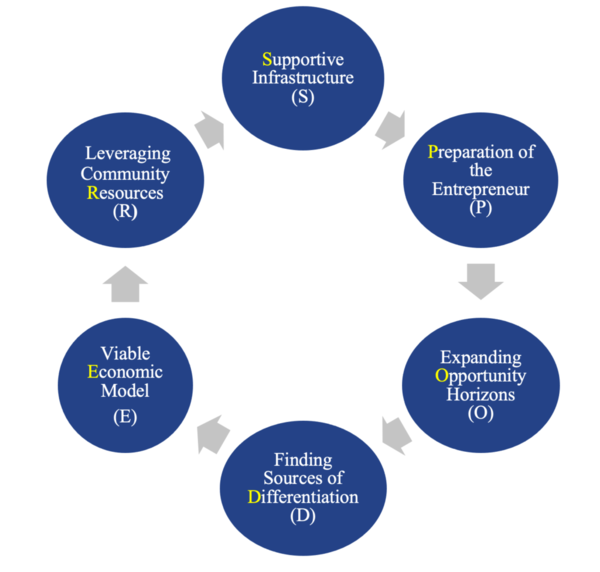Philosophy & Guiding Framework
Program Philosophy and Values
There is a need to do more than simply enable people to survive when in poverty or adverse conditions. We believe that the goal must be to eliminate poverty, and that entrepreneurship represents one vehicle for doing so. Further, we believe that anyone is capable of creating a sustainable enterprise. We approach entrepreneurship as a journey of many steps. Our purpose is to walk part of this journey hand-in-hand with entrepreneurs who come from adverse circumstances. We model the journey around eighty steps and believe that for every step we can help an individual take, the individual will take two more steps on their own. We seek to level of playing field so that everyone can experience the empowering and transformative potential of entrepreneurship.
A Guiding Model: SPODER

As universities, nonprofits and others attempt to address poverty and adversity through entrepreneurship, there is also a need for a framework to guide their efforts. Toward this end, we have adopted the SPODER framework developed by Morris, Santos and Neumeyer (2018):
S) Developing a supportive infrastructure
The framework begins with development of a supportive infrastructure (S), which includes addressing basic infrastructure needs (e.g., literacy, transport, safety, childcare, health care, wireless networks, and so forth) and adapting elements of local entrepreneurial ecosystems to better serve the poor (e.g., entrepreneurial education/training mechanisms, availability of finance, incubators/accelerators, a supportive business community, vehicles for social networking/connecting, small business support organizations, small business service providers, entrepreneurial role models, and entrepreneurial mentors). Low-income neighborhoods generally lack an entrepreneurial ecosystem, and the poor struggle to tap into whatever ecosystems exist within the larger community or region.
P) Preparation of the individual
We then focus on the low-income individual and their preparation (P) for the entrepreneurial journey. The key here is addressing gaps in key literacies and helping the individual master business and entrepreneurial competencies. It is critical to prepare individuals in adverse conditions to become entrepreneurs, providing them with the knowledge, tactics and tools to think and act more entrepreneurially.
O) Expanding the entrepreneur’s opportunity horizon
Next, entrepreneurship is opportunity-driven behavior, and our focus becomes the opportunity horizon (O) of the entrepreneur. Here the priority is to continually extend this horizon, enabling the low-income individual to recognize more attractive and higher potential possibilities both as the basis for launching the venture, but also to enable ongoing growth and expansion of the business.
D) Sustainable differentiation from competitors
Based on the market opportunity, a business is conceptualized. All too often, the value proposition on which the business is based is not sufficiently unique. When this happens, customers see the business as a commodity. It becomes difficult for the entrepreneur to achieve sustainable differentiation (D) from competitors. The key is strategic thinking, as opposed to reactive or tactical management, as sources of differentiation exist for virtually any business.
E) Development of a viable economic model
Then, the business designed by the low-income entrepreneur must be developed around a viable economic model (E). This typically means not trying to compete with high unit costs, relatively small volumes, and low prices and margins. Rather, the entrepreneur must find innovative ways to capture revenue, price on a value basis, achieve cost economies while keeping overhead low, and reach higher potential market segments.
R) Obtain resources through leveraging and creative means
Finally, the low-income entrepreneur must continually acquire resources (R), which includes not only money, but a wide range of other tangible and intangible resources. However, the key concept here is resource leveraging, which means finding creative ways to borrow, share, rent, outsource, barter, partner and otherwise tap into resources not owned by the entrepreneur, including community resources. It involves recognizing things as resources that others do not, taking advantage of one’s surroundings, and using resources in non-conventional ways.